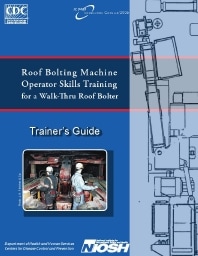Mining Publication: Roof Bolting Machine Operators Skills Training for a Walk-Thru Roof Bolter: Trainer's Guide
Original creation date: August 2006
Authors: WJ Wiehagen, SB Robertson, CW Urban, J Dickerson, RH Peters, C Vaught, LG Mallett, MJ Brnich, R Conkle, DP Cooper, D Thomas
NIOSHTIC2 Number: 20030932
Pittsburgh, PA: U.S. Department of Health and Human Services, Public Health Service, Centers for Disease Control and Prevention, National Institute for Occupational Safety and Health, DHHS (NIOSH) Publication No. 2006-135, Information Circular 9489, 2006
This trainer's guide is designed as a reference manual. The purpose is to offer information and examples to skills trainers to assist them in structuring training for new operators of Walk-Thru roof bolting machines. Trainers can use this manual as a resource for helping trainees learn, understand, and apply knowledge and skills. In this sense, the guide is not prescriptive. It is designed to offer information and trigger ideas on what might be done to accelerate learning to those who are new to the roof bolting task. On-site trainers can modify this guide to fit their conditions, machines and equipment, and work procedures. They can integrate roof control plans, company policies and procedures, and operators' manuals from the manufacturers of the original equipment into this guide. Every trainee is different and will come to the job with varying levels of relevant knowledge and skills. The trainer's decisions on where to start, how to organize the on-the-job and classroom training portions, and when and how to offer different aspects of the training will be based on (1) a pretraining assessment of the trainee's knowledge and skills and (2) the trainer's experience in conducting skills training. The "Skill Check" section might be useful for deciding where training should start among miners who have underground experience but limited knowledge of roof-bolting techniques. Every job carries a learning curve and likely has a number of "teachable moments" where significantly new knowledge and skills can be learned. The videos on the DVD that accompany this guide can be shown at the beginning of training to give trainees an idea of what the job entails and related requirements. They can also be used within the training cycle (after the trainee has some experience in the job) to reinforce key points or as a trigger for eliciting questions about particularly difficult parts of the job. The video segments are meant to be visual models of good performance. They are designed to elicit discussion on good (lower risk) ways to do the job. In this context, they can be used very creatively at different times within the training cycle. The section on "Talking Points" offers a number of questions that can be used in the classroom to support and elaborate on certain aspects of the job duties. If the trainee has a fair amount of underground experience, some of the questions can also be used to support the pretraining assessment (i.e., skill check) of knowledge and skills. Likewise, some of the questions can also be used while teaching on the job to reinforce key points affecting safety, production, or maintenance. The section dealing with a mine's roof control plan should be used at various times in the training cycle to make sure the trainee understands the plan and knows how to apply it in performing the job. The supplemental materials offer additional resources that can be used to support initial job training or follow-up. Learning continues well after an individual has been trained. The supplemental materials can help reinforce good operating skills and provide an opportunity for further discussion on better ways to do the job.

NIOSHTIC2 Number: 20030932
Pittsburgh, PA: U.S. Department of Health and Human Services, Public Health Service, Centers for Disease Control and Prevention, National Institute for Occupational Safety and Health, DHHS (NIOSH) Publication No. 2006-135, Information Circular 9489, 2006